
Wolfgang Amadeus Mozart was a prolific and influential composer of the Classical period. Despite his short life, his rapid pace of composition resulted in more than 800 works of virtually every Western classical genre of his time. Many of these compositions are acknowledged as pinnacles of the symphonic, concertante, chamber, operatic, and choral repertoire. Mozart is widely regarded as among the greatest composers in the history of Western music, with his music admired for its "melodic beauty, its formal elegance and its richness of harmony and texture".

Johann Georg Leopold Mozart was a German composer, violinist, and theorist. He is best known today as the father and teacher of Wolfgang Amadeus Mozart, and for his violin textbook Versuch einer gründlichen Violinschule (1756).

Anna Maria Walburga Mozart was the mother of Wolfgang Amadeus Mozart (1756–1791) and Maria Anna Mozart (1751–1829).
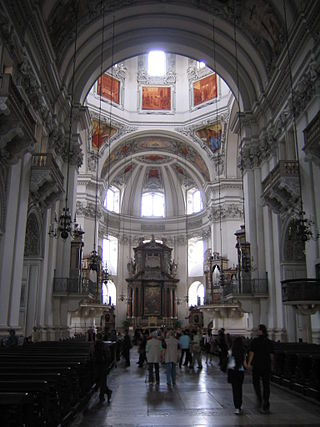
The Krönungsmesse, composed in 1779, is one of the most popular of Wolfgang Amadeus Mozart's 17 extant settings of the Ordinary of the Mass. It can be classified as either a Missa brevis or a Missa solemnis because although it includes all the sections of the Ordinary, it is relatively short.
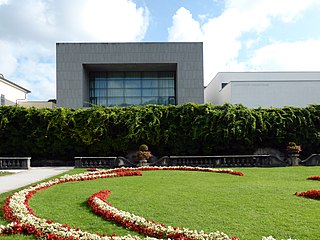
Mozarteum University Salzburg is one of three affiliated but separate entities under the “Mozarteum” moniker in Salzburg municipality; the International Mozarteum Foundation and the Mozarteum Orchestra Salzburg are the other two. It specializes in music, the dramatic arts, and to a lesser degree graphic arts. Like its affiliates it was established in honour of Salzburg-born musician Wolfgang Amadeus Mozart.
Joseph Leutgeb was an outstanding horn player of the classical era, a friend and musical inspiration for Wolfgang Amadeus Mozart and Joseph Haydn.

Mitridate, re di Ponto, K. 87 (74a), is an opera seria in three acts by the young Wolfgang Amadeus Mozart. The libretto is by Vittorio Amedeo Cigna-Santi, after Giuseppe Parini's Italian translation of Jean Racine's play Mithridate.
Hans Graf is an Austrian conductor.
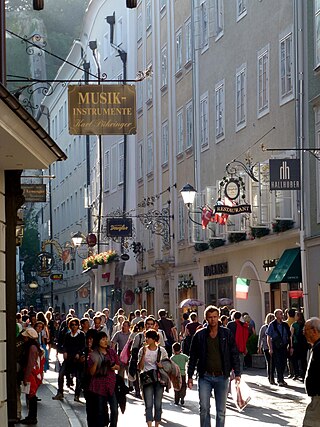
Getreidegasse is a busy shopping street in the historic Altstadt of Salzburg, Austria, a UNESCO World Heritage Site since 1996. It is known for the birthplace of Wolfgang Amadeus Mozart at No. 9, where he lived until the age of 17. The narrow street is characterised by numerous high townhouses side by side with its wrought iron guild signs.

The Symphony No. 8 in D major,, by Wolfgang Amadeus Mozart is dated December 13, 1768. Mozart wrote the symphony in Vienna, when he was twelve years old, at a time when he and his family were already due to have returned home to Salzburg. In a letter to his friend in Salzburg, Lorenz Hagenauer, Leopold Mozart says of the delay that "we could not bring our affairs to a conclusion earlier, even though I endeavored strenuously to do so." The autograph of the Symphony No. 8 is today preserved in the Staatsbibliothek Preusischer Kulturbesitz in Berlin.
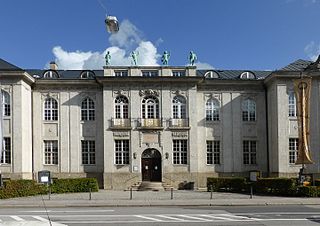
The International Mozarteum Foundation was founded in 1880 in Salzburg with its primary concern being the life and work of Wolfgang Amadeus Mozart. Closely affiliated with the Mozarteum University Salzburg, it was preceded by the Cathedral Music Association and Mozarteum of 1841. It collects Mozart memorabilia, maintains the Mozart library, the Mozart birthplace and other Salzburg locations linked with Mozart. The Foundation also promotes research regarding Mozart and administers various awards such as the Mozart Medal, the Preis der Internationalen Stiftung Mozarteum, the Lilli Lehmann Medal, and presents up to twenty other performances year-round.

"Conservati fedele" is a concert aria for soprano and orchestra by Wolfgang Amadeus Mozart.

The Mozart family grand tour was a journey through western Europe, undertaken by Leopold Mozart, his wife Anna Maria, and their musically gifted children Maria Anna (Nannerl) and Wolfgang Theophilus (Wolferl) from 1763 to 1766. At the start of the tour the children were aged eleven and seven respectively. Their extraordinary skills had been demonstrated during a visit to Vienna in 1762, when they had played before the Empress Maria Theresa at the Imperial Court. Sensing the social and pecuniary opportunities that might accrue from a prolonged trip embracing the capitals and main cultural centres of Europe, Leopold obtained an extended leave of absence from his post as deputy Kapellmeister to the Prince-Archbishopric of Salzburg. Throughout the subsequent tour, the children's Wunderkind status was confirmed as their precocious performances consistently amazed and gratified their audiences.
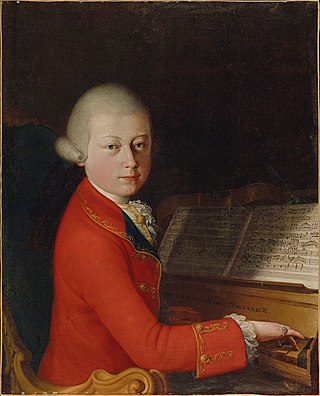
Between 1769 and 1773, the young Wolfgang Amadeus Mozart and his father Leopold Mozart made three Italian journeys. The first, an extended tour of 15 months, was financed by performances for the nobility and by public concerts, and took in the most important Italian cities. The second and third journeys were to Milan, for Wolfgang to complete operas that had been commissioned there on the first visit. From the perspective of Wolfgang's musical development the journeys were a considerable success, and his talents were recognised by honours which included a papal knighthood and memberships in leading philharmonic societies.

The Historic Centre of the City of Salzburg, also known as the Altstadt, is a district of Salzburg, Austria, recognized as UNESCO World Heritage Site since 1996. It corresponds with the historic city center, situated on the left and right banks of the Salzach river.
Wolfgang Plath was a German musicologist specialising in research on Wolfgang Amadeus Mozart.

Wolfgang Rehm was a German musicologist active mostly in music publishing, especially the Neue Mozart-Ausgabe. He was on the board of its editorial team for decades, and personally edited operas and piano music. While he worked on it for Bärenreiter in Kassel, he was responsible for the program of the Kasseler Musiktage festival, and after he moved for further work to Salzburg, he shaped the program of the Mozartwoche. He was also a member of the International Association of Music Libraries, Archives and Documentation Centres from 1959 to 1985, and also a founding member and treasurer of the Répertoire International des Sources Musicales data base.

Wolfgang Amadeus Mozart composed four litanies in his service as a church musician for the Salzburg Cathedral, two of which are settings of the Litaniae Lauretanae, the Litany of the Blessed Virgin Mary. The other two are settings of the Litaniae de venerabili altaris sacramento, venerating the Eucharist. Mozart composed the works for four soloists, choir, instruments, and continuo. The litanies appeared in Bärenreiter's Neue Mozart-Ausgabe (NMA) in 1969.
The Concertone for two Violins and Orchestra in C, K. 190 (186e) was written by Wolfgang Amadeus Mozart in May 1774.















